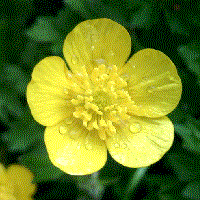 |
RANUNCULACEAE - The Buttercup Family
There are around 1800 species in this family, which is found mainly in the colder regions of the world. Most of them are well-known wild flowers or garden flowers, including Buttercups, Anemones, Delphiniums, Aquilegias and Clematis. Some species, particularly Aconitum, are poisonous. Nearly all members of the family are herbaceous, with Clematis being the only woody species. |
Characteristics of this Plant Family:
Leaves, Stem & Roots ~ The leaves of this family are usually divided or lobed, but are heart-shaped in Ranunculus ficaria (Lesser Celandine) and narrow and undivided in some species of Ranunculus. They usually arise from the base of the plant, or alternately up the stem, but in Clematis they are opposite. The perennial species form a small rhizome or tuber which develops new roots each year.
Flowers ~ The flowers may be solitary, but they are frequently in clusters or spikes. In many species, there are no proper petals, and it is the brightly coloured calyx which forms the 'flower'. There are usually five sepals, although there may be many, and they come in a wide variety of shapes. Those in the genus Ranunculus, the Buttercups, are the only ones which have a true calyx and petals. There are many stamens surrounding many fused carpels.
Seeds ~ The seeds are carried in several different types of fruit. In Actaea (Baneberry), it is a berry; in Clematis, each seed develops a hard woody coating and a fluffy tail, but in most species the seeds develop either as a globe from which they separate when they are riper or inside a (usually five-sided) capsule which splits at maturity to release them (as in Aquilegia).
Members of this Family usually have:
Five coloured sepals instead of petals (except Buttercups)
Divided leaves
Non-woody tissue (except Clematis)